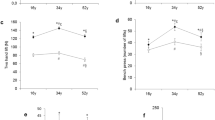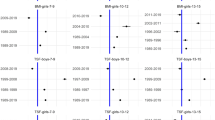Abstract
A sample of 989 male youngsters aged 11–18 years was subdivided into three groups by the type and amount of their physical activity as follows.
Group 1 (G1) had a maximum of three curricular PE classes a week, without any additional organized physical activity. With the same number of PE lessons Group 2 (G2) had at most three sessions of sports training per week in addition. Group 3 (G3) had a weekly minimum of five training sessions in addition to the PE lessons at school.
The subjects of G3 had significantly higher relative aerobic power, larger relative muscle mass and smaller relative body fat content than the subjects of the other two groups.
The effects of sports training on the development of physical working capacity are undeniable, but to explain such differences observed in relative aerobic power between the groups requires also the consideration of inheritance and selection procedure.
Similar content being viewed by others
References
Al-Hazzaa, H.M. and Sulaiman, M.A., 1993.Maximal oxygen uptake and daily physical activity in 7- to 12-year-old boys. Pediatric Exercise Science, 5: 357–366.
Bale, P., and Goodway, J., 1990.Performance variables associated with the competitive gymnast. Sports Medicine, 10: 139–145.
Barber, G., 1995.Training and the pediatric patients: a cardiologist’s perspective. In Blimkie, C.J.R. and Bar-Or, O. (Eds.), New Horizons in pediatric Exercise Science. Human Kinetics, Champaign IL. pp. 137–146.
Bar-Or, O. 1983.Pediatric Sports Medicine for the Practitioner. Springer, New York-Heidelberg-Berlin-Tokyo.
Bar-Or, O., Skinner, J.S., Berstenova, V., Shearburn, C., Bell, C.W., Royer, D., Haas, J., and Buskirk, E.R., 1971.Maximal aerobic capacity of 6–15 year old girls and boys with subnormal intelligence quotients. Acta Paediatrica Scandinavica, Supp. 217: 108–113.
Bouchard, C., Boulay, M.R., Simoneau, J. A. Lorite, G., and Pérousse L., 1988.Heredity and trainability of aerobic and anaerobic performances — an update Sports Med., 5: 69–73.
Bouchard, C., Boulay, M.R., Dionne, F.T., Pérousse, L., Thibault, M.C. and Simoneau, J.A., 1990.Genotype, aerobic performance and response to training. In Beunen, G., Ghesquire, J., Reybrouck, T., and Classens, A.L. (Eds.).Children and Exercise. Ferdinand Enke Verlag, Stuttgart. pp. 124–135.
Demeter, A., 1981.Sport in Wachstums- und Entwicklungalter— Anatomische, physiologische und psychologische Aspekte. Johan Ambrosius Barth, Leipzig.
Drinkwater, D.T., and Ross, W.D., 1980.Anthropometric fractionation of body mass. In Ostyn, M., Beunen, G., and Simons, J., (Eds.), Kinanthropometry II. University Park Press, Baltimore MD. pp. 178–189.
Eiben, O.G., Farkas, M., Körmendy, I., Paksy, A., Varga Teghze-Gerber, Zs, and Vargha, P., 1992.The Budapest Longitudinal Growth Study, 1970–1988. Humanbiologia Budapestiniensis, 23: 13–202.
Fraisse, F., Desnus, B., Handschuh, R., Jousselin, E., Strady, M., and Thomaidis, M., 1992:Maximal oxygen uptake in high level athletes under 20 years of age. In Coudert, J., and Van Praagh, E. (Eds.):Pediatric Work Physiology — Methodological, Physiological and Pathological Aspects., Masson, Paris-Milan-Barcelona-Bonn, p. 160.
Frenkl, R., 1990.Gyermek-sportélettani ismeretek és alkalmazásuk. In: Mèszáros, J. Szerk): A gyermeksport biologiai alapjai. Sport, Budapest. pp 186–212.
Frenkl, R. Szabó, T., and Mészáros, J. (1990a):Seleccion de deportistas de edad infantil. Archivos de Medicina del Deporte, 25 (7): 71–78.
Froberg, K., Andersen, B., and Lammert, O., 1991.Maximal oxygen uptake and respiratory functions during puberty in boy groups of different physical activity. In Frenkl, R., and Szmodis, I. (Eds.): Children and Exercise — Pediatric Work Physiology XV. National Institute for Health Promotion, Budapest, Hungary, pp. 265–280.
Galioto, F.M., 1990.Exercise rehabilitation programs for children with congenital heart disease: A note of enthusiasm. Pediatric Exercise Science, 2: 197–200.
Hagberg, J.M., and Coyle, E.F., 1983.Physiological determinants of endurance performance as studied in competitive race walkers. Medicine and Science in Sports and Exercise, 15: 287–289.
Lortie, G., Bouchard, C., Leblanc, C., Tremblay, A., Simoneau, J.A., Theriault, G., and Savoie, J.P., 1982.Familial similarity in aerobic power. Hum. Biol., 54: 801–812.
Kasch, F.W., Boyer, J.L., and Van Camp, S.P., 1990.The effect of physical activity and inactivity on aerobic power in older man (a longitudinal study). The Physician and Sportsmedicine, 18: 73.
Kemper, H.C.G. (Ed; 1995).The Amsterdam Growth Study —A Longitudinal Analysis of Health, Fitness and Lifestyle. HK SPort Science Monograph Series, 6, HK, Leeds LS.
Kovar, R., 1981.Human Variations in Motor Abilities and its Genetic Analysis. Charles University, Prague.
Ma Li-Hong and Chen Jia Qi, 1985.A study of hereditary influence on ventilatory responses in children and anaerobic powers in girls. Abstracts of the International Conference on Sports Medicine Beijing p. 128.
Ma Li-Hong and Chen Jia Qi, 1987.Cardiopulmonary function of twin children during rest and exercise. The Journal of Tienjin Institute of Physical Education, 2 (1): 78–85.
Mészáros, J. (Szerk; 1990).A gyermeksport biológiai alapjai. Sport, Budapest.
Mészáros, J., Petrekanits, M., Mohácsi, J., Farkas, A., and Frenkl, R., 1991.Aerobic capacity and anthropometry of adolescent boys. InFarkas, Gy.L. (Ed.):Papers of the Scientific Session in Szeged (Hungary), 1990. JATE — University of Ulm Szeged Ulm 181–187.
Mészáros, J., Frenkl, R., Petrekanits, M., Farkas, A., and Mohácsi, J., 1992b.Anthropometric and exercise physiological characteristics of young male athletes grouped by weight-related aerobic power. In: Coudert, J. and van Praagh, E. (Eds.): pediatric Work Physiology — Methodological, Physiological and Pathological Aspects. Masson, Paris-Milan-Barcelona-Bonn pp. 147–150
Mohácsi, J. and Mészáros, J., 1987.Stature and body mass in Hungarian schoolchildren. In Branicevic J., Kusec, V., Lethbridge, M., Milicic, J., Peranovic, M., Rudan, P., Smolej-Narancic, N., Sujoldzic, A., and Simic, D. (Eds.): Eighth International anthropological Poster Conference, Zagreb pp. 20–22.
Mészáros, J., Szmodis, I., Mohásci, J., Sabir, R.A., and Kovács, E., 1988.Body build and some aspects of motor performance of female university students of physical education. In Eiben, O.G. (Ed.): Current Development in Kinanthropometry. Human biologia Budapestiniensis, 18: 133–136.
Parizkova, J., 1961.Total body fat and skinfold thickness in children. Metabolism, 10: 797–804.
Patterson, D.H., and Cunningham, D.A., 1985.Development ofaerobic capacity in early and late maturing boys. In Binkhorst, R.A., Kemper, H.C.G., and Saris, W.H.M. (Eds.): Children and Exercise XI. Human Kinetics, Champaign IL. pp. 119–128.
Pechar, G.S., and Ng, K.N., 1992.Personal Fitness, Kendall/Hunt Publishing Company, Kerper IA.
Perrault, H., 1995.Benefits of exercise training after surgical repair of congenital heart disease. A theoretical perspective. In Blimkie, C.J.R., and Bar-Or, O. (Eds.). New Horizons in Pediatric Exercise Science. Human Kinetics, Champaign, IL. 123–136.
Petrekanits, M., 1995.A mellkas borének homérsékletvaltozasa mint terheléses élettani mutato. Korosztalyonkénti és sportagankénti osszehasonlitas. Kandidatusi értekezés, kézirat, Magyar Testnevelési Egyetem, Budapest.
Pérousse, L., Lorite, G., Leblanc, C., Tremblay, A., Thériault, G., and Bouchard, C. (1987).Genetic and environmental sources of variation in physical fitness. Ann. Hum. Biol., 14: 425–434.
Prud’Home, D., Bouchard, C., Leblanc, C., Landry, F., and Fontaine, E. (1984).Sensitivity of maximal aerobic power to training is genotype-dependent. Medicine and Science in Sports and Exercise, 16: 489–493.
Reybrouck, T., Weymans, M., Stijns, H., and Van der Hauwaert, L.G., 1986.Exercise testing after correction of tetralogy of Fallot: The fallacy of reduced heart response. American Heart Journal, 112: 998–1003.
Rhodes, J., Garofano, R.P., Bowman, F.O., Grant, D.P., Bierman, F.Z., and Gersony, W.M., 1990.Effect of right ventricular anatomy on the cardiopulmonary response to exercise (Implication for the Fontam Procedure). Circulation, 81: 1811–1817.
Rutenfranz, J., 1986.Longitudinal approach to assessing maximal aerobic power during growth. The European experience. Medicine and Science in Sports and Exercise, 18: 3. 270–275.
Ruttenberg, H.D., Adams, T.D., Osmond, G.S., Conlee, R.K., and Fisher, A.G., 1983.Effects of exercise training on aerobic fitness in children after open heart surgery. Pediatric Cardiology, 4: 19–24.
Shephard, R.J., 1985.Changes in lung function, ball-handlingskills and performance measures during adolescence in normal school boys. In Binkhorst, R.A., Kemper, H.C.G. and Saris, W.H.M. (Eds.): Children and Exercise XI. Human Kinetics, Champaign IL. pp. 252–259.
Seliger, V. and Bartunek, Z., 1976.Mean values of various indices of physical fitness in the investigation of Czechoslovak population ages 12–55 years. Czechoslovak Association of Physical Culture, Prague.
Simon, H.B., 1992.Testedzés, egészég és sportorvoslás. Az Orvostudomany Aktualis Kérdései No. I. Medicina, Budapest, pp. 1–33.
Szollár, L., 1986.Az elhizás kórélettana. Medicina, Budapest.
Tomassoni, T.M., Galioto, F.M., Vaccaro, P., and Vaccaro, J., 1990.Effect of exercise training on exercise tolerance and cardiac output in children after repair of congenital heart disease. Sports Training, medicine and rehabilitation, 2: 57–62.
Weiner, J.E.L. and Lourie, J.A. (Eds.). 1969Human Biology — A Guide to Field Methods. IBP Handbooks, No. 9, Blackwell, Oxford.
Wessel, H., Cunnigham, W., Paul, M., Bastainer, C., Huster, A., and Indriss, F., 1980.Exercise performance in tetralogy of Fallot after intracardiac repair. Journal of Cardiovascular Surgery, 80: 852–893.
Williams, J.R., Armstrong, N., Winter, E.M., and Crichton, N., 1992.Changes in peak oxygen uptake with age and sexual maturation in boys: Physiological fact or statistical anomaly? In Coudert, J., and Van Praagh, E. (Eds.): Pediatric Work Physiology — Methodological, Physiological and Pathological Aspects. Masson, Paris-Milan-Barcelona-Bonn, pp. 35–37.
Zhan Min Yuan and Lu Shao Zhong, 1986.Study of VO 2 max in students from 13–23 years of age. Chinese Journal of Sports Medicine, 5 (4): 211–217.
Yoshizawa, S., Ishizaki, T., and Honda, H., 1986.Aerobic power and endurance running in young children. In Rutenfranz, J., Mocellin, R., and Klimt, F. (Eds.): Children and Exercise XII. Human Kinetics, Champaign IL. pp. 77–90.
Author information
Authors and Affiliations
Rights and permissions
About this article
Cite this article
Frenkl, R., Mészáros, J., Petrekanits, M. et al. Aerobic power and anthropometric characteristics of Hungarian schoolboys. Hum. Evol. 13, 97–105 (1998). https://doi.org/10.1007/BF02439388
Received:
Accepted:
Issue Date:
DOI: https://doi.org/10.1007/BF02439388




